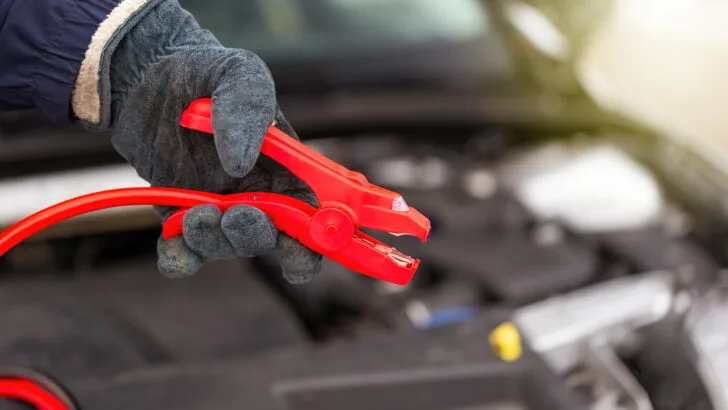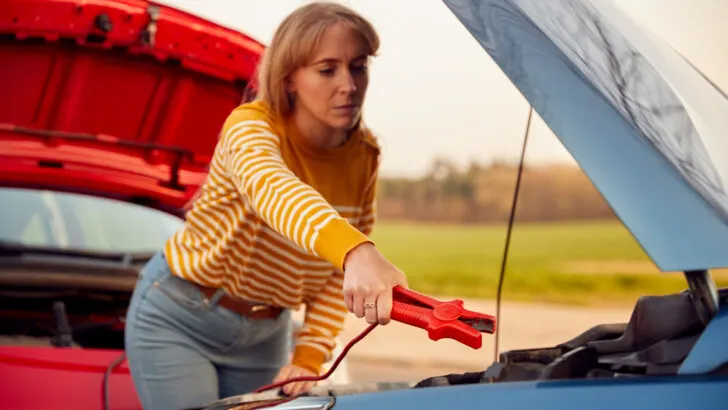Jumpstarting a car in the rain may sound dangerous to attempt. Is there any way to do it safely?
You can jumpstart a car in the rain as long as you are careful. Keep water away from any electrical components that it might damage. However, don’t be outside of your car at all if there is any lightning nearby, as you are much safer inside.
You can usually keep water from getting under your hood if the storm is not that bad, although that isn’t possible in more serious conditions.
How Does Jumpstarting a Car Work?
Usually, jumpstarting a car is done with two cars, one of which has a working battery. You open the hoods of both cars and use jumper cables to connect one battery to the other.
The jumper cables bring electricity from the working car to the car that has a dead battery and won’t start. This should allow the dead car’s engine to start and fully charge the battery.
Is Jumpstarting in the Rain Possible?
Everyone knows that water and electricity don’t mix. If you need to jump-start your car while it’s raining, is there any safe way to do it despite the rain?
Contrary to what you might assume, it is possible to do this. It is not always a huge safety risk. You have to take certain precautions, but it is not dangerous.
How Dangerous Is It?
Even if you do get shocked, you won’t get electrocuted. Getting shocked by jumper cables certainly hurts, but it won’t kill you. The voltage is too low to kill someone.

Another risk is damage to your car battery or some other part of your car. The hood of your car can mostly prevent rain from touching whatever is under the hood. You can also use an umbrella to protect your car.
Watch Out for Lightning
Don’t get out of your car in the middle of a lightning storm. Being struck by lightning isn’t as rare as some people think, so lightning should be taken seriously.
If you are about to jump your car and see lightning, get back in your car. It is dangerous to be outside near your car and relatively safe to be inside it.
Lightning Storms Don’t Last Long
Most likely, it will all be over in less than half an hour, maybe much less. You might be worried about being late for whatever you are doing.
However, it isn’t worth the risk to be outside of your car when there is lightning. Show up late and explain the situation. Better yet, call beforehand and explain why you will be late.
Precautions When Jump Starting in the Rain
You might get hurt or damage your battery if you don’t follow the right precautions.

Everything that is important when jump-starting elsewhere is just as important in the rain. There are also additional risks when it is raining. Don’t let water touch the connectors on your battery, as that could damage it.
Drain Water From the Battery
Even if your car battery is already wet, you can still jump-start your car. First, drain any water from your battery. Then, make sure you dry everything properly before you use the cables.
Keep Everything Dry
Any water anywhere under your hood is dangerous. Water allows electricity to travel from one part of your car to another, which can wreck sensitive electronic components.
Keep Water Away From Everything Under Your Hood
Usually, getting a small amount of water under your hood won’t do any damage. However, some damage is a possibility. Many devices under your hood are vulnerable to short circuits.
Remember the Basics
The red wire is always positive and the black is always negative. Always attach the red before the black. Make sure you connect everything securely.
Don’t Let the Clips Touch
If you let two jumper cable clips touch each other, sparks will shoot everywhere. This could injure you or damage the battery.
Jump Starting Your Car
First, turn everything off. If your lights are on, this drains electricity, and you need as much electricity as possible to make the jump work. Don’t leave the heat, air conditioning, or radio on either.
First, connect the red clamps to the red battery terminals. Start with the donor car (the one with a working battery) and attach the clamp to the car you are jumpstarting second. Don’t attach the clips backward, or else you will blow a fuze and the car won’t work until you replace it.
Then, attach the two black cables in a different way. Don’t attach both ends of the black cable to the battery terminals. Instead, attach one clamp to the donor car’s battery terminal and the other to a different metal part of the other car, such as the engine block.
Start the Two Cars
First, start the donor car’s engine. Wait for a few minutes, because it takes time to transfer electricity to the dead battery.
Then, try starting the engine of the car that needs to be jump started. After only a few minutes of charging, it should start. If it doesn't work, wait a while and charge the battery further before you try again.
Remove the Cables Safely
Removing the cables the wrong way is unsafe. Remove the clips in the exact opposite order you attached them. Don’t let the clamps touch each other or touch anything metal.
Key Takeaways to Jumpstarting Your Car in the Rain
Jumpstarting your car in the rain is not that dangerous. Your battery probably won’t get wet. Even if something goes wrong, the electricity in a car battery isn’t usually enough to kill someone.
The car hood is often enough to protect everything from the rain. You can also use an umbrella.
Lightning is more dangerous than some people think. Don’t be outside of your car while there is a lightning storm going on. It will likely be over in less than 30 minutes.
